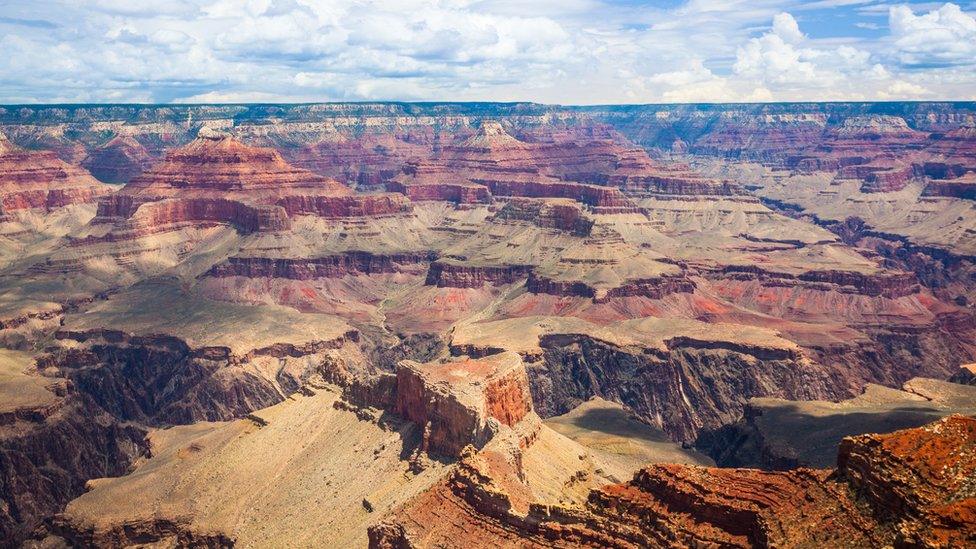What is the history of the Grand Canyon?
- Published
- comments

On 26 February 1919 - exactly 100 years ago today - the Grand Canyon in Arizona in the US became an official National Park.
Lots of events are taking place throughout the year to celebrate this park's big birthday.
Millions of people visit the canyon every year, but for a long period of history, it was an unexplored part of the world.
The canyon was created as a result of water erosion of the Colorado River, which flows through it. It is believed the river made its course through the canyon about six million years ago.
People knew about the Colorado River - which stretches from its source in the Rocky Mountains of Colorado to the Gulf of California - but the Grand Canyon section remained a bit of a mystery.
The Grand Canyon was created as a result of water erosion of the Colorado River, which flows through it
Now, we know that people have been based in and around the canyon from over 10,000 years ago, when hunter gatherers used to pass through.
We know this because of archaeological evidence, such as homes, artefacts and food storing areas which they left behind.
But there is still more to explore.
What is the history of the Grand Canyon?
The first Europeans to reach the Grand Canyon did so in the 16th Century.
Spanish explorers first ventured into the south rim in 1540, but they didn't find anything of value so they turned back. It was many more years before European explorers would turn their attention back to the area.
Even as late as the mid-19th Century, the Grand Canyon was still known as 'The Great Unknown' because that's exactly what it was.
It was even left as a blank area on maps!
In 1857, an army lieutenant called Joseph Christmas Ives took a 50-foot steamboat up the river to explore the area. His boat crashed and he continued on foot, becoming the first European American known to reach the river within the canyon itself, although he did not explore the full length.
This travel poster to encourage tourists to visit the Grand Canyon is from 1939
He wrote about his expedition: "The extent and magnitude of the system of canyons is astounding. The plateau is cut into shreds by these gigantic chasms, and resembles a vast ruin.
"It seems intended by nature that the Colorado River, along the greater portion of its lonely and majestic way, shall be forever unvisited and undisturbed."
He couldn't have been more wrong.
The man credited as the first main explorer of the canyon was someone called John Wesley Powell.
In 1869, along with nine men in four small wooden boats, Powell headed up the Colorado River, through the canyon.
Major John Wesley Powell came up with the name that we all use today - the Grand Canyon
It was a treacherous trip and by the end, with few supplies left, it became a fight for survival. Many of his notes from this trip were lost and there are no photographs.
But he survived and led another expedition in 1871, which gave the world the first reliable maps of the Colorado River.
He was even responsible for giving the area the name we use today - the Grand Canyon.
This picture shows John Wesley Powell's boat called Emma Dean, which he named after his wife, on the Colorado River in the Grand Canyon during his second trip
Over the years, the canyon has also served as a mine, after a man called Dan Hogan came to the canyon in 1890 and explored it for mining potential. He also set up tourist facilities and around the turn of the century, the tourist industry around the Grand Canyon really started to take off.
Hogan sold his business to Madeleine Jacobs in 1946 who, at first, didn't realise the canyon's mining potential and focused more on the tourist side of things.
But when Jacobs realised the rich uranium available, according to the official National Park Service website, the canyon operated as "one of the most productive uranium mines in the region, in operation from 1953 to 1969".
Mining would eventually stop here when the market for uranium declined and it became very expensive to ship.
The first US president to really begin to protect the canyon as a place of national importance was Theodore Roosevelt.
The first US president to really begin to protect the canyon as a place of national importance was Theodore Roosevelt
He visited it in 1903 and, in 1906, signed a law that made it the Grand Canyon Game Reserve. Two years later, he made it a national monument.
"Leave it as it is. You cannot improve on it. The ages have been at work on it, and man can only mar it," he said.
Later, on 26 February 1919, US President Woodrow Wilson made the area a National Park by law.
And on 26 October 1979, it was designated a World Heritage Site, which means that you're not actually allowed to pick up chunks of rock and take them home with you as a souvenir, although you can buy them at tourist shops.
When it first opened as a National Park, around 45,000 people visited it each year. Now, this figure is around 6 million people.
- Published25 February 2019
- Published24 June 2013
- Published2 March 2015
